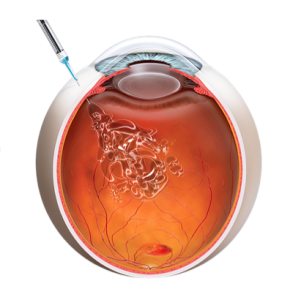Intravitreal injections
What is an intravitreal Injection?
It is an injection into the vitreous – the jelly-like substance inside your eye. It is performed to place medicine inside the eye, near the retina. This is a very effective way of delivering medication to the retina. It is an effective treatment option for a number of eye conditions. They are particularly effective when conditions are caught early.
Why is an intravitreal injection performed?
To deliver drugs to the retina and other structures in the back of the eye. Common conditions treated with intravitreal injections include
– macular degeneration
– diabetic retinopathy
– retino-vascular occlusions
– ocular inflammation
These conditions often require a course of repeated intravitreal injections as the affect of the drugs wears off over time.
What is the intravitreal injection procedure?
The eye is disinfected and a local anaesthetic is administered. The medicine is then injected into your vitreous: you may feel slight pressure on the eye when this is done.
What are the side effects?
After the injection the eye will feel gritty and watery for up to 24 hours before it starts to settle and feel normal again. There may be localised redness at the site of the injection from localised superficial bleeding under the clear skin or conjunctiva that covers the white of the eye, this is known as a subconjunctival haemorrhage and will settle spontaneously over the next week. Sometimes you may see round floaters at the bottom of your vision. These are tiny bubbles of air – they are harmless, and will be absorbed by the eye within 24 hours.
You should not drive after having an intravitreal injection in your eye.
Are there any risks?
Injecting any medication into the eye may result in complications. It is possible that you may get an infection within your eye (endophthalmitis) as a result of the intravitreal injection. The risk of this is low (estimated at less than 1 per 1000 injections). An infection may lead to vision loss or, in rare cases, loss of the eye.
The symptoms of an infection following an injection are increasing pain, generalised redness of the white part of the eye, loss of vision and increased floaters. If any of these symptoms are present after an injection you should contact your treating ophthalmologist immediately
What drugs are injected?
The most common drugs that are used for intravitreal injection are Lucentis, Eylea, Avastin, Triamcinolone and Triesence.
Where is the procedure undertaken?
Intravitreal injections can either be done in the consulting rooms or in the day surgery.
